Lisa Dawn's Blog: The Princess Blog, page 46
May 4, 2021
Let's Talk About True Love's Kiss
Every so often, someone makes a silly complaint about a Disney Princess movie instilling poor morals, and I am always ready to defend it. The latest silly accusation stems from the opening of Snow White's Enchanted Wish at Disneyland Park. This refurbished dark ride is a reimagining of the former Snow White's Scary Adventures with new animatronics in honor of Disney's year-long Ultimate Princess Celebration. Amongst the new animatronic showcases is a pivotal scene from the classic 1937 animated film in which the prince gives Snow White true love's kiss, reviving her from a deathly slumber so that she can be free to live out her happily ever after. A few days ago, two journalists from a publication called SFGATE released an article complaining about this non-consensual kiss that has put the internet into an uproar. Let's discuss the moral ethics of true love's kiss.
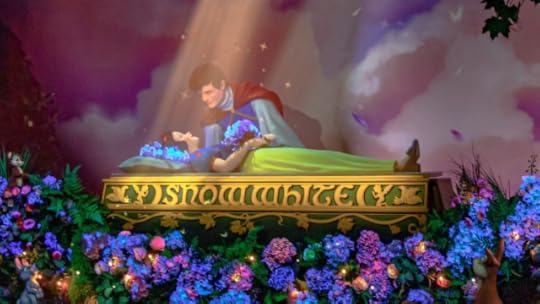
The concept of true love's kiss is not unique to "Snow White and the Seven Dwarfs." Many fairy tales and fairy tale-inspired films invoke this concept as the most effective method to break a curse. A kiss of true love is "not just any kiss," as Ursula explains to Ariel in The Little Mermaid about how to restore the curse on her voice. This means that a magical spell-breaking kiss will only work if it is from a person that the princess loves and wants to be kissed by. Enchanted played with this concept by having Prince Edward fail to wake Giselle from her curse when it turned out that he wasn't her true love after all. When Robert kisses her and she open her eyes, she smiles and says "I knew it was you." In any fairy tale where a curse must be broken by a kiss, it is intrinsically required that the kiss is mutually desired.
That doesn't mean, however, that cursed princesses are never taken advantage of in their sleeping states. In a version of "Sleeping Beauty" called "Sun, Moon, and Talia" by Giambattista Basile, the cursed maiden is raped by a king, gives birth to two children in her sleep and awakens after one of her children sucks the flax from the spindle out of her finger. Disney's Snow White and Princess Aurora were fortunate enough not to suffer such a terrible fate. Disney's "Sleeping Beauty" reimagining, Maleficent , goes as far as exploring the validity of Aurora's desires by not having her wake up when Phillip kissed her after knowing her for even an shorter time than he did in Disney's 1959 Sleeping Beauty . Therefore, we can rest assured that Snow White was ready and willing for her prince to come exactly when he did if singing "Someday My Prince Will Come" during the film's midpoint was not enough evidence already. Contrary to what the authors of the SFGATE article believe, the spell would not have broken if had not been true love's kiss.
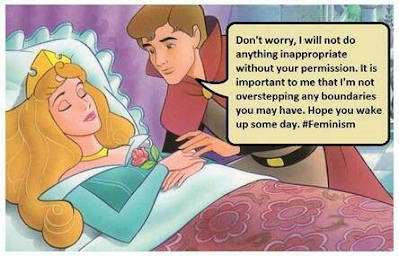
Let's say, for argument's sake, that the curse's magic was not intuitive about love and that any kiss would have broken it. Does that mean that the prince should not have kissed her and instead should have waited for someone more malicious like the king from Basile's version of "Sleeping Beauty" to do it for him? Think of the curse as the equivalent of a disease with a kiss as the only procedure that could cure the life of the afflicted patient. Would it be better to let them die rather than undergo a minor potential risk from the procedure? If a person is physically unable to communicate their own medical decisions, their closest relative is granted power of attorney. There's no way to know for sure that this relative's decision will align perfectly what the patient wants, but as someone who loves them, they have to do what they think is best. Though Snow White is not yet married to the prince at the end of her movie, the only relative she had was the one who cursed her to die in the first place. Therefore, we can assume from her desire to marry the prince that he is the closest thing she has left to next of kin. Why wouldn't he want her to survive and live out their mutual dream to unite in matrimony?
The undeserved outrage over this beautiful new animatronic is just another example of how modern feminism is overpowering the femininity that we love about our favorite heroines. I, for one, am thrilled that the updated ride includes this pivotal and reassuring moment from the movie's climax that reassures audiences that Snow White would achieve her happy ending after everything she suffered through at her stepmother's hand. Modern versions of "Snow White" like Once Upon a Time prove that her character can be strong and empowering without needing to give up the desire for love. Her story is one of the most romantic fairy tales ever written because it proves that love can not only be validating, but life-saving as well.
May 2, 2021
Review: Awaken
Though I wasn't sure what to expect from Camille Peters' new fairy tale book after reading the last one, I am pleased to say that Awaken is now my favorite book in The Kingdom Chronicles along with Identity. It may be no coincidence that these two books are connected by a recurring character, Archer, who was the brother of the protagonist in Identity and the love interest of the protagonist in Awaken. This is a creative retelling of "Sleeping Beauty" that focuses on a specific aspect of the 1959 Disney adaptation rather than anything from the original fairy tale. It never ceases to amaze me how many creative ways authors have found to retell this story in a way that allows the sleeping princess to be more active while remaining true to the heart of the original.
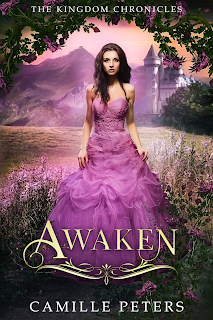
The heroine from Awaken suffers from a bad case of amnesia. She refers to herself as Primrose even though she knows it isn't her real name. When she first encounters Archer in the woods and forgets him the next day, I got the impression the book would turn into a fairy tale version of 50 First Dates, but the cursed maiden struggles more to remember her past than her present, so she quickly grows to become familiar with him. Primrose lives in a cottage with three peasant women who she refers to as her aunts, which is a blatant Disney reference. In the Disney version of "Sleeping Beauty," Princess Aurora is raised to believe that she was born a peasant and that her beloved Prince Phillip is a peasant as well. This misunderstanding causes distress for both of them when they learn that they are in an arranged royal marriage, unaware that the arrangement is with each other. Awaken explores that moment of distress by making Archer prejudiced against royals without knowing that the woman he has fallen in love with is one of them.
The focus on class struggle is a unique and creative way to explore the "Sleeping Beauty" story that I have never seen outside of the Disney movie, where it became a moot point at the end. The metaphor of awakening from inner prejudice fits well into today's culture of "wokism" of accepting each other's differences and struggles. When Primrose recovers her memories as Princess Reve, she realizes that she was not a very good person. She decides to use her experiences living in the woods with her aunts to improve her character so she can be worthy of Archer's affections. Archer must also put aside his preconceived notions of royalty, especially toward his sister, who married a prince against his wishes in an earlier book from this series. Awaken is a beautiful story of learning to forgive people for their past mistakes and love them for who they are in the present.
The similarities to the "Sleeping Beauty" story mostly end with the Disney references. There are no fairies in this version, and the curse was not cast by an angry party guest who wasn't invited to Reve's christening. Instead, the climax ties into the other books from the Kingdom Chronicles series by making Reve's mother the evil queen who caused all of the fairy tale-related problems that she and her siblings faced in past and future books. This simplifies the series by giving it a common villain but allows little time to understand the villain's motivations in this book or to give her a satisfying ending. Like all the other books in this series, the primary focus is love overcoming obstacles as opposed to good vs. evil. The love story between Reve and Archer is charming, though develop feelings for each other a bit fast.
Overall, Awaken is a sweet and pleasant retelling of "Sleeping Beauty" that presents the beloved fairy tale in an original and creative way. The journey for Reve to recover her memories will be sure to keep readers on the edge of their seat as they wonder what she would remember next. Her romance with Archer translates well to modern society and class struggles. Reve never feels like a helpless damsel in distress despite her inability to take a walk in her own forest without getting lost. I would recommend this book to anyone who enjoys love stories or wants to discover a fresh take on "Sleeping Beauty."
April 28, 2021
Review: Disney Princess Tales of Courage and Kindness
As soon as I learned that yesterday's Ultimate Princess Celebration came with a free ebook, I scoured the internet to find and read it. Tales of Courage and Kindness contains 14 short stories that each feature a different official Disney Princess and two bonus stories that about Queens Anna and Elsa that take place after Frozen 2. The book's illustrated novella format reminds me of a two-book series I found many years ago called Once Upon a Princess, which retold each princess's story from her point of view. This book differs from that format in that it is told in the third person narrative, but the compilation of different princess stories accompanied by beautiful illustrations is still similar. Each short story is written by a different author and illustrated by a variety of artists, each with their own unique and colorful style.
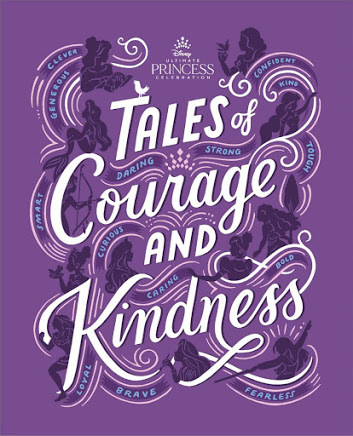
There isn't much point in reviewing each short story individually when you can read them all for free online, so instead, I will go over some highlights and recurring themes. Each story does a beautiful job of capturing the spirit of the Disney Princesses as kind-hearted and rebellious young women who go out of their way help those around them, especially those who are outcasts or underprivileged. The stories reminded me of what was so great about Disney's animated Little Mermaid series, which contained similar themes. From Belle learning to communicate with a Moroccan ambassador despite the language barrier to Rapunzel creating a Braille star chart for a blind astronomer, each story emphasizes the princesses' desires to encourage tolerance of those who are different than them, a popular narrative in today's princess media. Though some of the stories included the princes in the background, none of them were focused on romance. Sometimes the lack of love stories in modern media bothers me, but that wasn't the case here because it was so nice to see my favorite female leads make new friends and form closer bonds with the few female sidekicks that already existed in their stories. One story that stood out in this respect was Pocahontas, who befriended three English sisters that settled near her village after John Smith left. John was the only English settler in her movie that she had any genuine contact with, so it made sense that she would meet others after he left and she remained in the village. It was an added treat for her to interact with female characters her own age besides Nakoma.


I like that these stories take place at various points in the princesses' lives, showing that the authors were not limited by the events of their movies or sequels. Ariel's story takes place when she is still a mermaid, while Mulan's is shortly after returning to her village prior to the events of her sequel. I particularly enjoyed reading the story about Cinderella because it gave a rare look at a time in her life where she actually impressed Lady Tremaine as a result of being kind to her stepsister, Anastasia. It would be difficult to imagine that her stepmother was cruel to her every second of the time that she lived under her roof, so it was nice for Cinderella to achieve a win for herself and get on her stepmother's good side without external help for one fleeting moment. The only story that I would have preferred to see take place in a different time was Merida's. the author placed her tale right in the middle of the movie Brave, which made it feel too much like a summary of the film instead of an original story. Other than that, the tales in this book felt like gazing into a magic mirror at a secret part of each princess's life that we would never have otherwise gotten to see. Since they were written as one-offs for a single book, the stories felt more genuine and less commercialized than the Disney Princess Enchanted Tales series that Disney attempted over a decade ago.

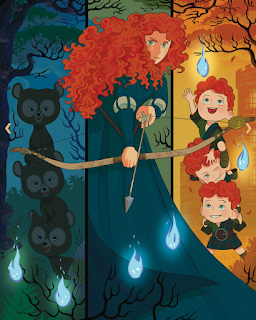
Of all the stories in this book, Jasmine's was the felt the most out of place and didn't make sense given her character's background. She is the only official Disney Princess who wasn't the main character in her own movie, so perhaps the author felt she needed to stretch our suspension of belief to get a good enough story to match the rest of the themes in the book. In this tale, Jasmine becomes the team captain for a group of princesses who participate in a game of polo in a tradition that dates back to when her mother was alive. Where the theme of female friendship resonated beautifully for Pocahontas, it was awkward and confusing for Jasmine. The original Aladdin movie asserts that Jasmine was raised alone and had no friends besides Rajah. For her to know these other princesses well enough to lead them in a team and be familiar with her mother's activities in the game seems to contradict everything we already know about her. On a personal level, I had trouble getting into this story because I don't like sports, but Jasmine also never came off as a particularly athletic princess. Even when she managed to jump across the rooftops of Agrabah using a wooden beam, she seemed just as surprised by her own skills as Aladdin was. It was also odd that all the male characters from the original film acted like mindless cheerleaders with nothing to talk about other than how much they supported Jasmine winning the match, which is the exact opposite problem that I had with the animated Aladdin series, which placed too much focus on the male characters.


All in all, Tales of Courage and Kindness is a charming anthology that contains all the things I love about princesses. Most of the stories stay true to the core of each princess's being and what makes her special. I love that they didn't feel like generic lessons for children about morals and that each author took the time to explore a good time and place for the event in each princess's life and what sort of unique challenges she might face in her own individual kingdom. It is littered with breathtakingly gorgeous illustrations in numerous styles from pencil art to paper art to more traditional-looking storybook drawings. If you are a fan of the Disney Princesses, this book is a must read. It is free at www.disneyprincessstories.com from now until August. Happy reading!
April 27, 2021
Disney Launches the Ultimate Princess Celebration!

The talented ladies Broadway Princess Party have been licensed by Disney to perform in an official Disney Princess concert tour. What's interesting about this to me is that Laura Osnes, who started the Broadway Princess party, has never worked for Disney in an official capacity until now, even though she has sung many of their songs onstage alongside Broadway's original Belle, Susan Egan, and Jasmine, Courtney Reed. I guess Disney was so impressed with their performances that they decided to take the Broadway Princess Party for themselves. Aisha Jackson, who understudied as Anna in the Frozen musical will be joining the party as well. The event is described on the official D23 website as "an unforgettable evening of story, animation, and song, alongside their magical musical director and an enchanting guest Prince." Even though Disney is not referring to the Broadway Princess Party by name, it sounds like the same the show, and I'm wondering if the original version is going to stick around much longer after Disney takes over. I'm also curious about any changes Disney might make to the concert after it gets touched by their magic.

Since it's Disney, this celebration will include a flood of new merchandise, including a book from Disney Publishing called Tales of Courage and Kindness . The book includes 14 original short stories that "demonstrate how the Disney Princesses, as well as Queens Anna and Elsa, are kind and courageous, each in her own way." The book is available to download now through August at disneyprincesstories.com along with upcoming videos of various Disney Princess voice actresses reading their stories out loud. You can share your own stories with Disney Princess-themed journals and stationary sets from The Happy Planner. Funko has also released some exquisitely detailed figurines of Ariel, Jasmine, Tiana, and Aurora, complete with animal friends and environments, which is a welcome change from their overly simplified standard designs. In honor of the princesses' giving nature, Disney has partnered with Starlight Children's Foundation to give princess-themed hospital gowns to children in need, a truly worthwhile endeavor.
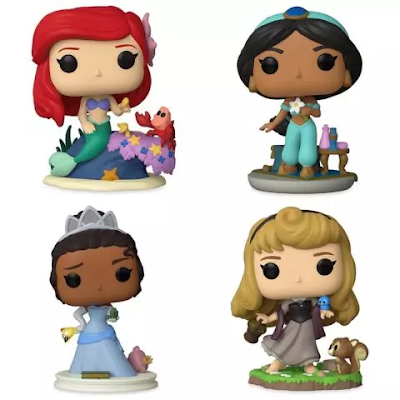
If you haven't heard the news yet, Disneyland is opening up this week after over a year of lockdown. They will be participating in the Ultimate Princess Celebration with with a brand new version of Snow White's Scary Adventures called Snow White's Enchanted Wish. This animatronic dark ride is a complete reimagining of the original ride feature new lighting, music, animation, and more, similar to how Walt Disney World reimagined it with the Seven Dwarfs Mine Train. Hong Kong Disneyland is celebrating with their impressive new Castle of Dreams, which draws inspiration from 13 different Disney Princess castles and stories. A brand new exhibit called Building a Dream: The Magic Behind a Disney Castle will feature a behind-the-scenes look at the imagineers' process in building the castle from conception to completion. Even if you don't plan on visiting the parks any time soon, it looks like there will be plenty of Disney Princess goodness to enjoy during this year-long celebration!
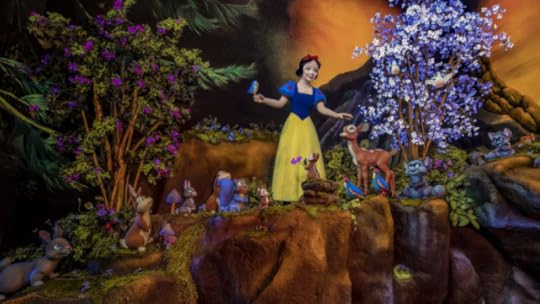
I try not to get my hopes up with the direction princesses have been heading, especially when it comes to Disney. Today's announcement took me by surprise in a good way. I am thrilled to see that the characters I love are being given the attention they deserve and spreading their message of hope and kindness throughout the world with music, events, and specials. Even princesses as old-fashioned as Snow White have something positive to offer during today's difficult times. With so much hopelessness in the world right now, we need their positivity more than ever, and I can't wait to partake in all of these different ways to celebrate my love of princesses. Which part of the Ultimate Princess Celebration are you most excited about? Let me know in the comments!
April 26, 2021
Review: Time Princess - Phantom of the Opera Visual Novel
The Time Princess app has been releasing an endless stream of new visual novels with no sign of slowing down. I've been impressed with the amount of well-known stories the game developers have adapted lately that aren't based on popular fairy tales. The latest one is no exception. Phantom of the Opera is a beloved story among princess fans due to its similarities to "Beauty and the Beast" as well as the beautifully haunting melodies of the famous Andrew Lloyd Webber musical. The innocent protagonist who performs various onstage arias in glittering costumes, best friend side character, and classic love triangle make it a prime choice for this game's traditional visual novel story dynamics. That is probably why it is one of the only stories in the game that is presented exactly as it is without any sort of modern twist such as gender-bending the characters like they did for several other adaptations.
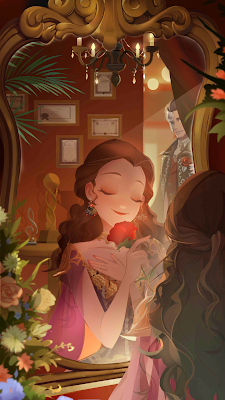
In this dress-up visual novel, players take on the role of Christine Daaé, a young aspiring opera singer who takes lessons from a mysterious angel who lives inside her mirror. Meanwhile, the Paris Opera House (as seen previously in Find Me in Paris) is in peril from a number of mysterious attacks by a phantom who never shows his face. The visual novel sticks closely to the events of the musical and I'm assuming the original novel by Gaston Leroux as well, though I have never read it. It is a love triangle between Christine, the Phantom, and her childhood sweetheart, Raoul. Christine doesn't remember Raoul at first when he visits her to see her performance at the opera house, but he is persistent in seeking her out until she does. When she discovers that the Phantom poses a real threat to her and the people around her, Christine ends up leaning on Raoul to protect her. The visual novel also incorporates a Persian man from the novel named Daroga, who is more knowledgeable about the phantom than Raoul and does a much better job advising her and keeping her safe, even though his connection is never explained.
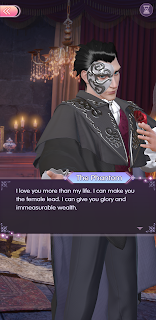
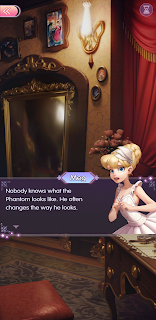

The story tree in this visual novel is formatted similarly to Swan Lake. Whether the player chooses to romance Raoul or the Phantom during the story's major turning points, it changes very little until the final level, at which point all of the decisions made previously will determine which endings are accessible for either Raoul or the Phantom. This is the first story in this game containing a dead end, meaning that there is a level that gives you a bad ending no matter which decision you pick, creating the illusion of a dynamic story path when it is actually linear. I thought that was rather clever on behalf of the developers since you never know how linear a story path will be in Time Princess until you start playing it. There is a surprisingly large number of potential endings, though most of them can only be accessed from the final chapter, requiring several days of grinding goodwill for the love interests just to complete the story.
It is possible to play the events of the visual exactly like the musical or to run away with Raoul before the Phantom threatens to destroy the opera house and avoid the climax entirely, which would end it around when the song "All I Ask of You" takes place in the musical. There are several different endings where Christine can choose the Phantom, though this version provides little reason why she would want to. The musical allows the audience to sympathize with Erik when Madame Giry explains how she rescued him from being tortured in a freak show as a child. Erik only mentions in passing that he does terrible things because of his facial deformity, but we never see him being tortured over it. He looks extremely handsome with the mask on, and the scene in the visual novel that reveals his face doesn't look that terrible either. This is such a visual game that even things that are supposed to be ugly are made softer and more aesthetically pleasing, which makes it difficult to portray this story in an accurate manner.
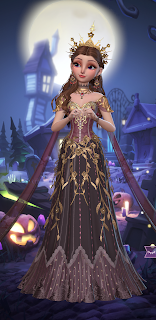
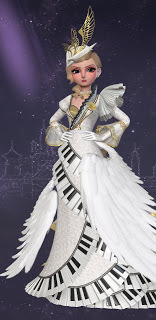
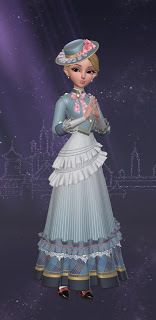
The costumes for this story in Time Princess did a great job at visually recreating various scenes and songs from the beloved musical. However, the developers were unable to license any of the music, which is a shame considering how iconic the songs are. Christine's "Think of Me" dress is a beautiful burgundy costume inlaid with golden leaf accents and a meticulously detailed gold crown that is one of my favorite hair accessories in the game. Her "Angel of Music" dress is an elaborate fantasy version of the white wedding gown that the Phantom forced her to wear in the musical. Time Princess's version is a more literal representation of the song title with swirling piano key accents and feathery white wings wrapping around the skirt. She also has a number of casual looks for when she is not performing.
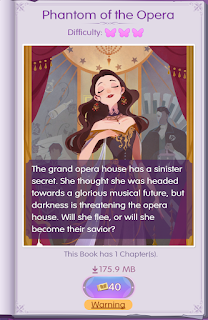
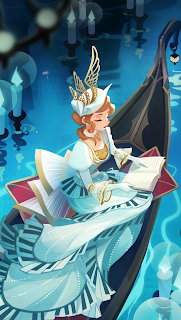
I liked this visual novel better than Helen of Sparta and Shadows of London because it had several satisfying endings, but I don't think it's the best story in Time Princess. While I'm glad the developers didn't try to mess around with the dynamics of the story too much, the single chapter format does not allow enough time to understand Erik's motivations or create sympathy for him. He comes off a psychopath who stalks Christine from her dressing room. Granted, he is portrayed similarly in the musical, but that version is more informative about his past, and the gorgeous Andrew Lloyd Webber melodies add to his emotional torment in a way that the game was unable to replicate with its generic visual novel background music. My favorite thing about this story is the visuals. I love Christine's opera dress and the beautiful new loading screen of her getting lost in a book as she sails to the Phantom's lair in her stunning "Angel of Music" dress.
April 25, 2021
Enchanted Kingdoms Review: Part 3
This is the third part of my review for the massive Enchanted Kingdoms fairy tale anthology. You can find the first part here and the second part here if you missed them. Today I am covering the first five books from the external file that is linked to at the end of the Amazon ebook. This was my favorite set of stories from this series so far. They stuck closer to the fantasy settings of original fairy tales than the previous books, which contained more sci-fi and horror. These are princess stories at their best, filled with more twists and turns than you would expect from a traditional fairy tale retelling, so let's dive right in!
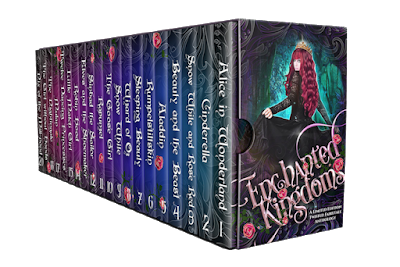
Crumbling Towers by Anne StrykerThis story is my favorite in this anthology so far. Not only is it the best "Rapunzel" adaptation I have ever read, but it is also one of the best fairy tale novels I have had the pleasure of experiencing. My only complaint is that it ended way too soon, which the author apologized for in her notes due to wanting to keep it around the same length as the other books. It combines the best parts of science fiction and fantasy. The story opens in a sterile computer world where a solitary girl is raised by robots and has never seen another human. When a suspicious young man finds her and helps her escape from her high-tech prison, she learns that the world is much bigger and more complex than she could have possibly imagined. The second half of the book is similar to The Princess in the Opal Mask by Jenny Lundquist, but a million times better. I was so invested in the story that I was more than a little disappointed by the abrupt ending that provided no closure for the characters I had grown to care about so deeply.
Robin's Hood by Jacque StevensThis is one of the most creative takes on "Robin Hood" that I've ever seen, reimagining the classic rogue as a woman in disguise. Disney attempted to do something similar in 2001 with their made-for-TV movie Princess of Thieves. While that version used the trope of giving the legendary hero a daughter who followed in his footsteps, this book explores what would have happened if Maid Marian and Robin Hood were one and the same. I appreciate that it doesn't use the traditional modern badass warrior woman archetype who could do no wrong. In this book, Marian is clumsy and nervous and mostly gets by on luck or help from her rowdy troupe of merry men. Her confidence and bravery are derived from her long-lost husband, Rob, whose memory allows her to take on a new persona when she dons his hooded cloak. The book is filled with twists and turns that will be sure to keep you on the edge of your seat right up to the final chapter.
Like Matches for Wishes by Lee Ann Ward"The Little Match Girl" is a depressing story, which is probably why there aren't that many adaptations of it. However, Lee Ann Ward managed to do the impossible and turn it into a happy tale of hope. Milla is a pauper who lives alone with her grandmother in a small village whose only worry in life is winning the affections of her crush, Jordy, until a brave knight tells her that she has a much bigger destiny in store. It is a straightforward rags to riches tale that reminds me of Don Bluth's Anastasia in the regard that both stories are about lonely girls who just want to know where they came from. Unlike the original story, this book has a traditional fairy tale ending. While that may take away some of the integrity of the work it was based on, it makes it a pleasant experience to read.
Queen of Snow by Laura Burton and Jessie CalThis one was a dud for me. It reminded me of Embers: Beastly Curses by Sky Sommers because it takes place in a generic fairy tale world that feels like a rewrite of ABC's Once Upon a Time. It uses similar ideas to the movie Happily N'Ever After and Ever After High, which both suggest that every fairy tale character's story is already written, and their endings are predetermined, so free will no longer exists for them. This trope doesn't usually work because it takes away the characters' agency as well as any motivation for the reader to find out the ending of their story. Throw in a character from the real world who is already familiar with fairy tales and Disney movies, and the whole book feels like a self-insert for the authors. "The Snow Queen" is a complex story with a lot of different elements and characters, but none of them were explored in this version, which made it a slog to get through.
A Siren's Broken Song by Nadira GoldeI was so pleased to find my favorite fairy tale included in this anthology! This book does a fantastic job of maintaining the integrity of Hans Christian Andersen's "The Little Mermaid" while simultaneously weaving a new tale. It expands upon a small portion of the story that is often overlooked--the period of time after the mermaid realizes that her love has betrayed her and must consider sacrificing herself as a result of the spell that turned her human. In this version, Letha is still able to speak and had only given up her siren song to become human. Even though she still has a voice, she is afraid to use it to ask for help after being rejected by the only person she ever loved. Thankfully, a dragon-man named Sebastian is too stubborn to back down when he discovers her plight. She enlists in his aid as well as several other magical beings of the sea as they explore ways to lift her curse. The story is similar to Saban's animated Little Mermaid series, which also brought in new characters to save the mermaid from her tragic fate.
April 19, 2021
Are Villains the New Disney Princesses?
When Disney released the trailer for their upcoming Cruella movie a couple of months ago, the internet had a lot to say. I decided it would be best to stay in my own lane. After all, 101 Dalmatians and its subsequent remakes are not Disney Princess movies. Then, it was announced last week that a new movie featuring Cinderella's stepsisters, Anastasia and Drizella, is in the works. Suddenly, Cruella didn't seem so irrelevant after all. It looks like villain-centered remakes are the next step in Disney's ongoing trend of poor decision-making and the general dearth of creativity in Hollywood. Don't get me wrong; I thought Maleficent was an excellent movie in its own right and quite innovative for the time period, but I wasn't expecting it to be the mold for a series of cookie-cutter screenplays about sympathetic villains after Disney ran out of animated classics to convert into soulless live-action remakes.

I've seen tons of backlash for Cruella from various sources. The gist is that Maleficent only worked because she did one bad thing in her life without clarifying her true motivation. Presenting the story from her perspective and having her show remorse for her mistake was an effective way to turn her into a sympathetic character. Cruella de Vil, on the other hand, had an undeniably selfish motivation in her desire to kidnap and murder puppies and showed absolutely no remorse for her actions. The preview for her upcoming film does little to justify that as it continues to convey her image as a daring fashionista who is willing to do whatever it takes to have the most innovative fashions among her competitors, even if that means lighting herself on fire. But I'm not here to talk about Cruella. I'm here to talk about the future of Disney Princesses, a future doesn't look very hopeful.

I don't think that a new about Cinderella's stepsisters is a bad idea and of itself, but having such a movie follow on the heels of Cruella implies that it will make Anastasia and Drizella Tremaine more redeemable than they probably should be. Plus, this storyline has already been explored by Disney multiple times. The 2002 film Confessions of an Ugly Stepsister aired on the Wonderful World of Disney and incorporated the same ideas. The biggest difference between that movie and the upcoming one is that the 2002 version was based on a fully fleshed out novel by Gregory Maguire, who is famous for penning Wicked . The new film is being written by a feminist comedy team that will likely excuse bad behavior as empowering. This is why Disney has been struggling to make new princess movies as of late. Our culture has reached a point where being feminine and well-behaved is seen as weak and outdated. The new model for girls is to take what they want, no matter the consequences. I shouldn't even need to explain why how dangerous that can be. Recent works for more feminine princesses like Rapunzel show their empowerment by forgiving people in their lives like Cassandra, who had done terrible things. Cinderella III: A Twist in Time also gave Anastasia a chance at redemption but still painted Drizella as a spoiled brat, which gives the more realistic perspective that not everyone is willing to change.

I haven't forgotten about Raya and the Last Dragon , an original animated princess movie that Disney released recently. Though it was was an excellent and creative movie, I don't think we're going to see another one like it anytime soon. Due to the pandemic, the movie had a limited release in theaters, and people who were already paying for Disney+ did not want to spend additional money to watch it. As a result, it was an embarrassing flop, which gives Disney the false impression that the public is not interested in original content from. Live-action remakes require very little story or character development and always bring in nostalgia bucks, so the mouse is more like to continue moving in that direction instead. Even Raya doesn't feel like the type of Disney Princess that I remember from my childhood. She is a warrior through and through and doesn't dress or act in a way that would be stereotypically feminine. The original Disney Princess model veers too far away from the latest cultural shift to remain relevant. Princesses are too young and inexperienced to be relatable to today's jaded audiences. They want strong queens who can stand up to any danger that gets thrown at them, not naïve damsels in distress. That isn't necessarily a bad thing, but if you head too far in the opposite direction, you end up with, well, villains.
What it means to be a Disney Princess by today's standards is very different from what it was ten, twenty, or thirty years ago. The classic romantic dreamer who never forgets her manners and is beloved by all who know her is an artifact of the past. Today's princesses are kickass pioneers who refuse to be told how to live their lives. While this type of behavior can seem empowering from a distance, it is only a few small steps away from villainy. I think Disney's upcoming slate of movies says a lot about how their characters have shifted from role models to troublemakers. The most telling sign that the Disney Princesses have lost their spark is the title of the upcoming sequel to Enchanted, Disnenchanted, which is how many of us feel about the new direction that Disney has taken their female-driven movies.
April 18, 2021
Review: The Faerie Prince
The Faerie Prince is the latest installment in the Fairytales of Folkshore series by Lucy Tempest. I have to say that this author's writing style has changed significantly since the original Thief of Cahraman trilogy. Her books used to overflow with lengthy and unnecessary exposition, and now they are succinct and to the point. This change was most noticeable in her "Cinderella" story, Princess of Midnight, which might be my favorite from this series. The Faerie Prince is the most simplistic book in the series to date, which might work a little to its detriment. It is an adaptation of "Snow White," but intentionally leaves out "and the Seven Dwarfs" from its marketing. It's just Snow White. I can only assume that Lucy cut these additional side characters to keep the story simple enough for a single book. but doing so turned a unique princess story into a generic fantasy romance adventure, albeit still a pretty good one.
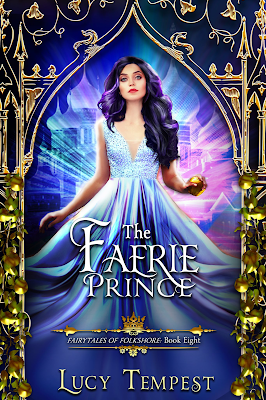
The Faerie Prince tells the story of Snezhana, a name that I could barely read in my head without giggling a little. It looks like the author was well aware of this because she had the love interest butcher the princess's name from the moment he meets her, referring to her as "Smudgy," an even funnier-sounding nickname. Snezhana seeks out Keenan for aid when she learns that her stepmother intends to kill her and eat her heart. What she doesn't realize at the time is that Keenan is a mischievous troublemaker, whose personality is likely inspired by Puck from Shakespeare's A Midsummer Night's Dream. I had a feeling that Keenan would eventually become a love interest after he popped up in several earlier books from Fairytales of Folkshore, but it was hard to picture him falling in love due to his mischievous nature. This book spends some time exploring that by revealing that his morbid sense of humor is derived from years of experience losing people he cared about due to his longer lifespan as a fae. Snezhana grows sympathetic toward his plight and soon realizes that she needs his spontaneity in her life after growing up as a princess in such a rigid setting.
As a love story, this book works really well. It brings together two people from different worlds and shows how opposites can complement each other if they are willing and able to work together. Cutting the seven dwarfs from this "Snow White" adaptation places the focus solely on the relationship between Snezhana and Keenan. They spend the majority of the book plotting to find a magical golden apple that would enhance Snezhana's powers to the point of being godlike so that she would be strong enough to defeat her stepmother, who was also after the powerful apples. Snezhana's strategic nature coupled with Keenan's impulsiveness allow them to come up with plans that they never would have thought of on their own and drives home the fact that they belong together. However, the story does not have much else to offer besides the romance. There are very few side characters, and nothing important happens outside of Snezhana and Keenan's quest for the apple. There are so many other stories out there where Snow White must learn to fight to defeat her stepmother that the concept feels a little stale.
Something else I liked about this book besides the romance is the imagery. There are some beautiful transformation sequences throughout the book with stunning descriptive detail as well as a metaphorical dream sequence that Snezhana and Keenan share when they drink a magic potion to learn about the future. Snezhana matches all of the physical features of the original Snow White, but it is revealed that she died her hair black to make herself less recognizable to her enemies. This is an interesting touch for the author to include since it is unusual for someone with such naturally dark hair to have such pale skin. I also liked all the descriptions of Keenan's fae features such as his pointy hair and unique eyes because it made him truly feel like an otherworldly being. Lucy Tempest is very good at worldbuilding and does so in this book in a way that is not distracting from the main story or characters. The enchanted apple garden was also a pleasure to experience through her writing.
If you are looking for a sweet romantic fantasy adventure, this book is perfect for you. It works as a standalone since I did not feel like I needed prior knowledge from the earlier Fairytales of Folkshore books, though they did give me a preconception of who Keenan is. The imagery and romance are beautifully presented in this simple adaptation of "Snow White." However, if you are a fan of the original fairy tale, you might find this story a bit lacking. There are no side characters, nor does it reference the poison comb or corset. If you are looking for a richer adaptation of that story, I recommend A Dream of Ebony and White by Melanie Cellier.
April 11, 2021
Enchanted Kingdoms Review: Part 2
This is the second review in a four-part series. If you missed the first part, you can find it here. I completed the next five books in the Enchanted Kingdoms anthology and was pretty disappointed. Every single adaptation in this section went for the dark gritty reboot version of the fairy tale ala Fate: The Winx Saga instead of a creative contemporary retelling. They include vampires, ghosts, or werewolves, making these five fairy tales feel like Halloween horror on steroids instead of an enchanted world, as the title of the anthology would suggest. These stories encompass the rest of the ebook that is provided when you order this set on Amazon. The other ten books in the series are included in a download link that is provided at the end. Hopefully, those books will be more optimistic because dang, I thought I had turned cynical toward fairy tales, but I had nothing on these writers.

Rumple's Revenge by Craig HalloranThis retelling of "Rumpelstiltskin" starts out pretty interesting by turning the focus of the story toward the king's lover, Luna, who is jealous of Felicia for taking her love away due to her alleged ability to spin straw into gold. The book soon spirals into a confusing mess involving vampires, failed murder attempts, and corruption. Felicia stops being a relatable character by the end of the story after she becomes selfish and greedy as a result of being forced to spin gold and marry the king. One thing I do like is that it gives a larger role to her father, who had gotten her into this situation in the first place by boasting about her nonexistent magical ability. The love triangle she has with Rumpelstiltskin reminds me of Stalks of Gold by Celeste Baxendell, but I thought that was a better adaptation overall because it didn't try to bite off more than it could chew.
Cursed Beauty by Stacey O'NealeThis "Sleeping Beauty" adaptation reminds me of Dagger's Sleep by Tricia Mingerink. Both stories feature a female protagonist who is chosen by birthright to awaken a sleeping prince who she harbored no romantic feelings toward in order to restore her kingdom. The biggest difference is that the main character in this book, Aurora, is a blood witch, who falls in love with a werewolf and must wake a sleeping vampire to save her coven. The sheer amount of horror archetypes in the book feels like the author was trying to complete a checklist of every stereotypical paranormal romance character out there, which takes some enjoyment out of the story. It is certainly a unique take on the fairy tale, but not one of my favorites.
City of Gold and Glass by Amanda MarinThis is my favorite book among the five I am reviewing today. It is a completely original take on L. Frank Baum's The Wizard of Oz that is full of heart and creativity. The opening chapter threw me off because I didn't understand how a grim reaper named Imogen could possibly be related to Dorothy. Then I realized that Dorothy is actually represented by a young man on the cusp of death named Evander. Imogen serves as his guide through the world of the afterlife, Aeturnum, and does her best to help him return to his sick mother and little sister on Earth. For a story about death, it is filled with a surprising amount of hope. Evander teaches Imogen what it means to be human, while she helps him navigate the trials and tribulations of the afterlife. They share a beautiful relationship that I thoroughly enjoyed watching unfold.
The Ruin of Snow by Lacy SheridanThis is by far the worst retelling of "Snow White and the Seven Dwarfs" I have ever read. If anything, it has more in common with "Marigo of the Forty Dragons" than Snow White thanks to its murderous protagonist who is supposed to be sympathetic. Neyva Morningspell is a witch who was born into a family of heartless killers. She has killed many times for her mother and does so again for selfish reasons at the beginning of the book. When she is unable to complete the ritual every which must perform to surrender their spirits to the witch goddess, she is forsaken by her witching family, similar to Sabrina in The Chilling Adventures of Sabrina. She finds a group of seven friends who are cursed to turn into different animals at night and agrees to help them lift the curse in exchange for shelter from her vengeful family. What follows is a series of murders, morally questionable decisions, and LGBT romance. I had to force myself to get to the end of this book because it was quite long, and I didn't care about Neyva at all even though I knew she was trying to become a better person.
Scarlet and Shadow by May DawsonAt least this one was short. This retelling of "Little Red Riding Hood" feels like a G-rated porno between a female hunter and a werewolf. It has vibes of Mr. and Mrs. Smith with the hunter and the hunted playing off each other's violent urges toward each other as sexual tension. Soon, they are forced to work together when Scarlet's friends betray her, and she and Shadow are placed a situation where they have to pretend to be lovers for their own survival. Are they just really pretending, though?
April 4, 2021
Review: The Princess Vow
The Princess Vow is the third book in the Kingdoms of Fable series by Erika Everest. It continues the story of the League of Princesses that began with Sienna in The Scarred Prince. Each book combines two seemingly unrelated fairy tales in a unique way. This one covers "Sleeping Beauty" and "Puss in Boots." It is the second novel adaptation I have read of "Puss in Boots," but of course, I have read many adaptations of "Sleeping Beauty," which gives this one some big shoes to fill. I don't think I would have enjoyed this book as much if I hadn't read the first two books in Erika Everest's series. It does a good job of further developing the other princesses from the dream world and their relationships with each other but doesn't work well as a standalone due to a lack of conflict within the story.
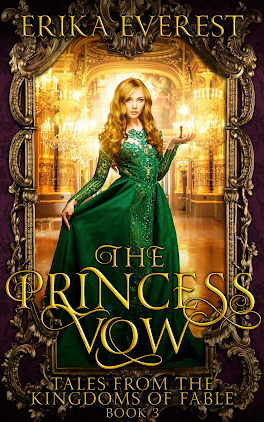
The Princess Vow continues the theme of sisterhood from the Kingdoms of Fable series. It focuses on two princesses, who happen to be sisters. Aurora is the fabled "Sleeping Beauty" character, and her sister, Rosebud, is determined to find a way to save her from the sleeping curse. My biggest issue with this book is that we don't truly feel Aurora's loss after she falls asleep. The Scarred Prince, the first book in the series, established a magical dream world where the princesses are linked by blood and visit each other in their sleep. Because of that, we know that Aurora isn't in any real danger when she enters another dream world that looks and feels no different from the real world. Not only is she still and conscious on some level, but she is also treated as a welcome guest in the castle of a man named O, who becomes a love interest for her. To me, living in a magical dream castle with a handsome prince figure doesn't feel like a curse at all.
Most of the action revolves around Aurora's sister, Rosebud, who takes on the responsibility of finding her and waking her up. Rosebud's journey is where the story overlaps with "Puss in Boots." She disguises herself as a boy for reasons which I cannot recall and encounters a talking cat who agrees to help her defeat the sorceress that cursed Aurora. Rosebud's story does not have very high stakes either as the sorceress she seeks out meets a quick end and barely poses a threat. I also wasn't particularly invested in her relationship with Puss, since they both meet each other under false pretenses. However, Rosebud's commitment to saving Aurora is one of the highlights of the book. It isn't the first version of "Sleeping Beauty" I've seen where a different type of love besides romantic love was needed to wake her, but it's still a refreshing contemporary twist on the tale.
Most of my enjoyment of The Princess Vow came from the references to its two prequels, The Scarred Prince and The Golden Ball. I grew fond of both Princess Sienna and Princess Natashya after reading these books, so it was nice to check in and see how they were doing. Several events from the earlier books overlap with this story, so it was also nice to see how everything came together. I was a little disappointed that this book did not cover the initial journey to the dream world where the princesses first met in its "Twelve Dancing Princesses" reference, especially since the timeline is already all over the place. Their backstory is one of the most intriguing aspects of the series even though it has only been referenced in hindsight. I would thoroughly enjoy a prequel that covers the entirety of this experience and how they worked together to free themselves from their captor.
I think The Princess Vow is the weakest book so far in Tales from the Enchanted Kingdom, but it is still worth reading if you have completed the other two books. It is a unique take on "Sleeping Beauty," with several contemporary twists that continues to emphasize the sisterly themes of the series. Its biggest flaw is that none of the characters are ever in any real danger, which is why I would love to read a sequel about how they overcame their first foe who trapped them in the dream world. I would not recommend this book as a standalone because I don't think I would have enjoyed it as much if I hadn't read The Scarred Prince and The Golden Ball first.



